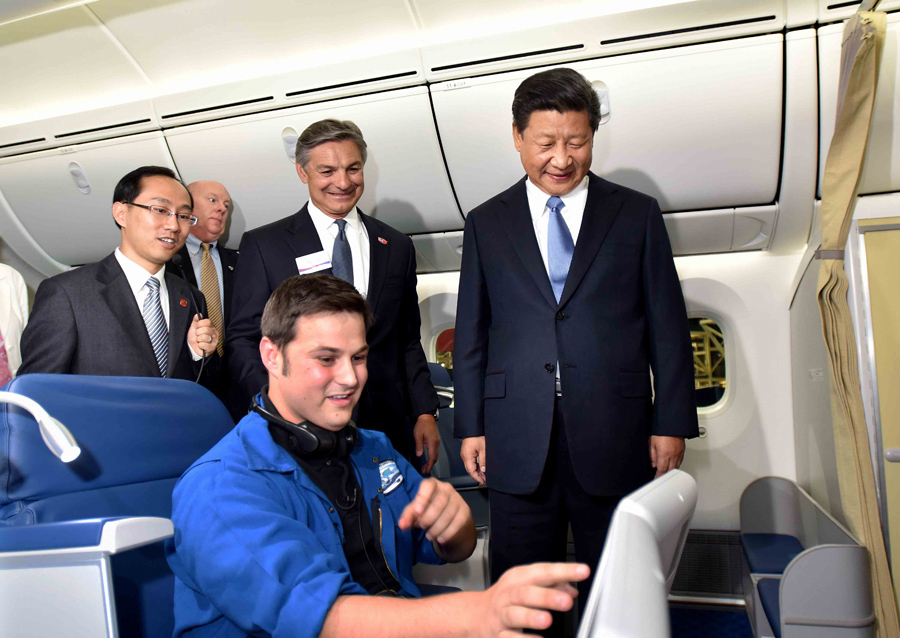Scholar: Holistic approach needed for China-US ties

Boeing executives lead President Xi Jinping on a factory tour.
Thirty-six years have passed since China and the US established diplomatic relations. At the invitation of US President Barack Obama, Chinese President Xi Jinping paid a state visit to the US from Sept. 22 to 25. How should the world understand this event? What is the future direction of China-US relations? Sun Zhe, professor at the Institute of Modern International Relations at Tsinghua University, shared his insights with Chinese Social Sciences Today (CSST).
CSST: President Xi talked about how to forge a “new type of major-country relations” between China and the US while giving a speech in Seattle on Sept. 22. He said the first and foremost challenge is to “correctly understand each other’s strategic intent.” Why is strategic reassurance so important to China-US relations?
Sun: Unsurprisingly, there is mutual suspicion between China and the US, which is related to a lack of understanding of each other’s history and culture. Moreover, the two countries have completely different political systems, which may partly explain why we think in different ways. Hopefully, President Xi’s visit can close the gap between China and the US public and inform the latter of what is going on here.
CSST: China and America have been cooperating with each other on various fronts. How are things going? Where are we now?
Sun: To evaluate bilateral cooperation, we need to avoid parochialism and approach the status-quo of China-US relations from a holistic perspective. There are four dimensions of China-US relations.
First of all, there are active and extensive people-to-people exchanges between the two countries. In 2014, a total of 4.3 million Chinese and US citizens visited each other’s country. Second, the cooperation between China and the US is substantive, involving science and technology, culture and even military sectors. In 2014, the two countries signed a set of agreements concerning climate change. Nonetheless, since China has already become the second-largest economy in the world, we cannot evade the fact that there is intense competition between the two countries. Moreover, seeds of conflict are inherent in China-US relations. For example, there are territorial disputes regarding the South China Sea and Diaoyu Island, yet they should be classified as “limited conflicts.” To avoid blind optimism or pessimism, we need to take into account all four dimensions.
CSST: The China-US Bilateral Investment Treaty (BIT) has attracted global attention. What are the new fronts for further cooperation between the two countries?
Sun: The negotiations over the BIT are expected to come to a successful conclusion by the end of this year. A milestone in bilateral trade and economic cooperation, it is no less important than China’s entry into the WTO and attainment of permanent normal trade relations from the US. During his state visit, President Xi met many business leaders from e-commerce, Internet and aerospace manufacturing sectors, such as top executives from the Boeing Company, forecasting a new era of bilateral cooperation in high-tech sectors.
CSST: As the world becomes increasingly flat, China-US relations are crucial not only to the two countries but to the international community.
Sun: Indeed, when we think about China-US relations, we should think globally. Japan, the Korean Peninsula, a weakened and unstable Europe—they all have a direct influence on China-US relations. In addition, it is worth pondering what kind of roles China and the US should play in the Middle East, Africa and Latin America. Leaders of the two countries need to keep in mind a grand vision and reach out for full-spectrum diplomacy.
Zhang Junrong is a reporter at the Chinese Social Sciences Today.
